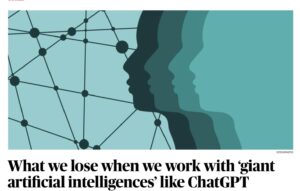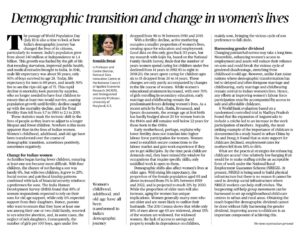- Effects of working with giant artificial intelligence

ChatGPT and other giant artificial intelligences (gAIs) are making headlines. ChatGPT is a large language model trained on internet text. It aims to create artificial general intelligence for the benefit of humanity.
However, gAIs lack democratic input and are designed top-down. They have various use cases, such as legal services, education, policy suggestions, and scientific insights, automating knowledge work previously considered impossible to automate.
Concept of ‘high modernism’
- High modernism refers to a philosophical and ideological perspective that emerged in the early 20th century.
- It is characterized by a belief in the power of scientific knowledge, rationality, and central planning to shape and improve society.
- High modernists prioritize order, efficiency, and measurable progress, often favoring large-scale infrastructure projects and standardized solutions.
- They aim to create a uniform and standardized society based on expert-driven decision-making and the application of scientific principles.
- In “Seeing Like a State,” James C. Scott explores the power dynamics of nation-states and their impact on society.
- When states implement top-down policies, they often oversimplify the complexity of human experience in favor of quantifiable measures.
- The prevailing philosophy, termed “high modernism,” prioritizes order and measurable progress but disregards local knowledge and lived experiences.
- This approach can have disastrous consequences, as exemplified by the failure to consider regional diversity in agriculture through monocrop plantations.
Negatives of Giant Intelligence
- The rise of gAIs could lead to language loss and a loss of diversity in our thoughts. Models trained predominantly on English and biased data from the internet may contribute to this risk.
- Other biases related to religion, sex, and race are also likely to be present in these models.
- At the same time LLMs like ChatGPT provide intelligible responses but lack multi-dimensionality. They are akin to an atlas, offering snapshots of the world but missing local knowledge and experience.
- gAIs prioritize the internet’s vast information, abstracting away “knowledge of the territory” held by individuals performing specific tasks.
- This territory can only be understood by the people that gAIs aim to replace.
Can diversity in gAI help ?
- gAIs lack understanding and can provide impressive answers based on specific prompts but fail when asked the same question differently.
- Some computer scientists refer to these systems as “stochastic parrots” because they mimic language but behave randomly.
- Positive research directions include BLOOM, an open-source LLM developed with public funding and extensive training data filtering. It is multilingual and has an active ethics team.
- Thwarting the risks of gAIs can be done by slowing down AI commercialization to allow for democratic inputs and promoting diverse model development.
- Diversity in models leads to better outcomes, as independent cartographers preparing different atlases with different focuses yield more comprehensive results.
- A better outcome is critical when dealing with the stakes involved in artificial general intelligence — an area of study in which a third of researchers believe it can lead to a nuclearlevel catastrophe.
Way forward
- Establish clear ethical guidelines and principles for the development and use of gAIs.
- Promote transparency in AI systems, including disclosing data sources and algorithms.
- Involve diverse stakeholders in decision-making processes to ensure ethical considerations are addressed.
- Curate diverse and representative data sets to reduce bias in training data.
- Regularly test and audit AI algorithms for bias and fairness.
- Implement techniques such as algorithmic auditing and interpretability to identify and mitigate bias.
- Define legal frameworks and regulations that assign responsibility for AI systems.
- Establish clear guidelines for liability when AI systems cause harm or make mistakes.
- Encourage organizations to adopt ethical and responsible practices in AI development and deployment.
- Making gAI as as supplementary to the human efforts and not its replacement.
Demographic transition and change in women’s lives

General Intro
- India’s demographic journey has impacted the lives of its citizens, particularly women, on the occasion of World Population Day.
- The population of India has grown significantly from 340 million at Independence to 1.4 billion due to improvements in public health, medical advancements, and reduced starvation.
- This has led to a decline in mortality rates, with increased life expectancy for men from 56 years in 1941 to 69 years today. As a result, parents no longer need to have multiple children to ensure survival, leading to a decrease in fertility rates from 5.7 in 1950 to 2.1 in 2019.
- highlights that these statistics conceal the profound changes in the lives of people, particularly women, as they adapt to longer lifespans and fewer children.
- The demographic transition has brought both positive and negative transformations to the various stages of women’s lives, including childhood, adulthood, and old age.
Change for Indian Women
- As families in India started having fewer children, ensuring the birth of at least one son became more challenging.
- The preference for sons, influenced by social norms, patrilocal kinship patterns, and financial insecurity, led to a higher reliance on sons for old age support.
- This resulted in sex-selective abortions and neglect of sick daughters. Consequently, the number of girls per 100 boys under the age of five decreased over the years.
- With declining fertility rates, women have more time for education and employment as the years spent caring for young children have reduced.
- However, early marriage and childbirth still heavily impact women’s lives, with the average age at first birth remaining low.
- Despite lower fertility rates, women face challenges in establishing stable connections to the labor market and gaining work experience, which limits their access to skilled jobs.
- By the time they are free from peak childcare responsibilities, they have missed the opportunity for skill-oriented occupations, leaving them with mostly unskilled work options.
- The demographic shifts also affect women’s lives in older age. With increasing life expectancy, the proportion of women aged 65 and above has risen significantly.
- While older men also increase in number, aging has unique implications for women.
- Women tend to marry older men and are more likely to outlive their husbands.
- This leads to a higher proportion of widowed women compared to men.
- Without access to savings and property, widowed women become dependent on their children, particularly sons, reinforcing the cycle of son preference.
Harnessing Gender Dividends
- Changing patriarchal norms takes time, but improving women’s access to employment and assets can reduce their dependence on sons and break the cycle of gendered disadvantage.
- However, unlike East Asian countries where demographic changes have led to delayed marriage and childbirth, early marriage and childbearing remain central to the lives of Indian women.
- Therefore, efforts to improve women’s labor force participation should be accompanied by accessible and affordable childcare options.
- A World Bank evaluation in Madhya Pradesh showed that expanding Anganwadis (childcare centers) to include a crèche resulted in increased workforce participation among mothers.
- A study conducted in urban China by Du and Dong highlighted the significance of childcare, as declining state support for it led to a decrease in employment rates among mothers from 88% to 66%.
Practical Strategies for enhancing Childcare
- One effective and achievable step towards improving access to childcare is to include the staffing of childcare centers as an acceptable form of work under the National Rural Employment Guarantee Scheme (NREGS).
- Currently, the NREGS focuses on physical infrastructure projects, but it can also be utilized to develop social infrastructure, such as supporting childcare facilities.
- The growing self-help group movement can also be leveraged to establish local childcare centers in both urban and rural areas.
- To fully benefit from the demographic dividend, it is crucial to harness the gender dividend by enhancing access to childcare.
3.Greenwashing : Changes to conservation laws must be backed by scientific evidence

Introduction:
- The Forest (Conservation) Amendment Bill, 2023, currently under deliberation by a Joint Committee of Parliament, is a contentious legislation highlighting the challenges in maintaining a balance between industrial development and forest conservation in India.
- The proposed amendments to the existing Forest (Conservation) Act, 1980 aim to incentivize private agroforestry and tree plantation activities.
- However, concerns have been raised regarding the potential consequences and effectiveness of the proposed changes.
Balancing Industrialization and Forest Conservation:
- Industrialization often leads to the encroachment of forest land and ecosystems, posing a threat to conservation efforts.
- The Forest (Conservation) Act, 1980 has been instrumental in regulating industrial exploitation and protecting forests.
- However, India’s forest cover has shown only marginal increases, with most growth occurring in orchards, plantations, and village homesteads rather than officially designated forests.
Amendments and Controversies:
- The proposed amendments aim to redefine the scope of the Act, limiting its provisions to land officially classified as “forest” after 1980.
- This excludes unclassified forest land or patches with forest-like characteristics.
- Additionally, the amendments grant states the authority to appropriate forest land up to 100 km near India’s borders for “strategic and security” purposes without central approval.
- Critics argue that these changes primarily promote commercial afforestation rather than natural forest regeneration.
Incentivizing Private Agroforestry and Carbon Credits:
- One of the main objectives of the amendments is to encourage private agroforestry and tree plantation activities.
- By incentivizing such practices, the government aims to increase India’s forest and tree cover.
- However, concerns arise regarding the long-term sustainability of private forests as permanent carbon stocks, as they may be susceptible to market forces that favor their utilization as “carbon credits.”
The Need for Scientific Evidence and Parliamentary Input:
- While adapting conservation laws to address new climate realities may be necessary, it is crucial to support such changes with rigorous scientific evidence.
- The parliamentary committee responsible for reviewing the Forest (Conservation) Amendment Bill has not yet expressed its opinion or suggestions, raising concerns about the decision-making process.
Conclusion:
The Forest (Conservation) Amendment Bill, 2023 presents a complex dilemma of balancing industrial development with forest conservation in India.
The proposed amendments have generated controversy, with concerns regarding the focus on commercial afforestation rather than natural forest regeneration.
The involvement of scientific evidence and parliamentary input is crucial to ensure effective and sustainable forest conservation policies in the face of evolving climate challenges.

